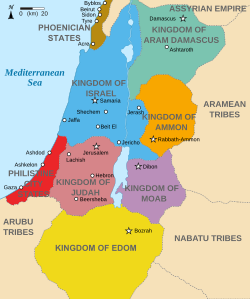
Back Koninkryk Israel Afrikaans مملكة إسرائيل (الشمالية) Arabic مملكة اسرائيل الشماليه ARZ شومالی ایسرائیل شاهلیغی AZB Ізраільскае царства Byelorussian Израилско царство Bulgarian ইসরায়েল রাজ্য Bengali/Bangla Rouantelezh Israel Breton Kraljevstvo Izrael BS Regne d'Israel Catalan
This article needs additional citations for verification. (January 2022) |
Kingdom of Israel 𐤉𐤔𐤓𐤀𐤋[1] | |||||||
|---|---|---|---|---|---|---|---|
| c. 930 BCE–c. 720 BCE | |||||||
 Map of the southern Levant in the 9th century BCE, with Israel in blue | |||||||
| Status | Kingdom | ||||||
| Capital | |||||||
| Common languages | Biblical Hebrew, Israelian Hebrew | ||||||
| Religion | |||||||
| Government | Monarchy | ||||||
| King | |||||||
• 931-910 BCE | Jeroboam I (first) | ||||||
• 732–c. 720 BCE | Hoshea (last) | ||||||
| Historical era | Iron Age | ||||||
• Established | c. 930 BCE | ||||||
| c. 720 BCE | |||||||
| |||||||
| Today part of | |||||||
The Kingdom of Israel (Biblical Hebrew: מַמְלֶכֶת יִשְׂרָאֵל, romanized: Mamleḵeṯ Yīśrāʾēl), or the Kingdom of Samaria, was an Israelite kingdom in the Southern Levant during the Iron Age, whose beginnings can be dated back to the first half of the 10th century BCE.[2] The kingdom controlled the areas of Samaria, Galilee and parts of Transjordan. The regions of Samaria and Galilee underwent a period with large number of settlements during the 10th century BCE,[3] with the capital in Shechem, and then in Tirzah. The kingdom was ruled by the Omride dynasty in the 9th century BCE, whose political center was the city of Samaria.
The Hebrew Bible depicts the Kingdom of Israel, also known as the Kingdom of Samaria, as one of two successor states to the United Kingdom of Israel ruled by King David and his son Solomon, the other being the Kingdom of Judah to the south. Many historians and archaeologists, however, do not believe in the existence of a United Kingdom as depicted in the Bible.[Notes 1]
The Kingdom of Israel was conquered by the Neo-Assyrian Empire around 720 BCE.[4] The records of Sargon II of Assyria indicate that he deported 27,290 Israelites – around one fifth of the population of the Kingdom of Israel[5] – to Mesopotamia;[6] this deportation became the basis for the Jewish idea of the Ten Lost Tribes of Israel. Some Israelites migrated to the southern kingdom of Judah,[7] while those Israelites that remained in Samaria, concentrated mainly around Mount Gerizim, came to be known as Samaritans.[8][9] Foreign groups were also settled by the Assyrians in the territories of the conquered kingdom.[9]
- ^
- Rollston, Chris A. (2010). Writing and Literacy in the World of Ancient Israel: Epigraphic Evidence from the Iron Age. Society of Biblical Literature. pp. 52–54. ISBN 978-1-58983-107-0.
- Compston, Herbert F. B. (1919). The Inscription on the Stele of Méšaʿ.
- ^ Arie, Eran (2023). "Canaanites in a Changing World: The Jezreel Valley during the Iron Age I". In Koch, Ido; Lipschits, Oded; Sergi, Omer (eds.). From Nomadism to Monarchy?: Revisiting the Early Iron Age Southern Levant. Penn State Press. p. 120. ISBN 978-1-64602-270-0.
[T]he growing proto-Israelite power in the central hill country, out of which would emerge the Northern Kingdom of Israel, [that] should be dated to the first half of the 10th century BCE.
- ^ Killebrew, Ann E., (2014). "Israel during the Iron Age II Period", in: The Archaeology of the Levant, Oxford University Press, p. 733: "In the Lower Galilee [...] during the Iron IIA, earlier Iron I settlements were deserted and appear to have been replaced by new large fortified sites [and] Zertal's landmark survey of northern Samaria [...] demonstrates a doubling of the number of sites from the Iron I to II [...] Finkelstein and Lederman's survey of the territory of Ephraim revealed [the] settlement density peaks in the later Iron II period, with over 200 sites identified [...]"
- ^ Hasegawa, Levin & Radner 2018, p. 55.
- ^ Cite error: The named reference
finkwas invoked but never defined (see the help page). - ^ Younger, K. Lawson (1998). "The Deportations of the Israelites". Journal of Biblical Literature. 117 (2): 201–227. doi:10.2307/3266980. ISSN 0021-9231. JSTOR 3266980.
- ^ Finkelstein, Israel (28 June 2015). "Migration of Israelites into Judah after 720 BCE: An Answer and an Update". Zeitschrift für die alttestamentliche Wissenschaft. 127 (2): 188–206. doi:10.1515/zaw-2015-0011. ISSN 1613-0103. S2CID 171178702.
- ^ Shen et al. 2004.
- ^ a b Finkelstein, Israel (2013). The forgotten kingdom : the archaeology and history of Northern Israel. Society of Biblical Literature. p. 158. ISBN 978-1-58983-910-6. OCLC 949151323.
Cite error: There are <ref group=Notes> tags on this page, but the references will not show without a {{reflist|group=Notes}} template (see the help page).
© MMXXIII Rich X Search. We shall prevail. All rights reserved. Rich X Search